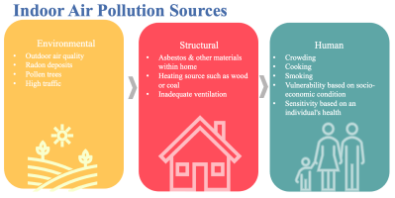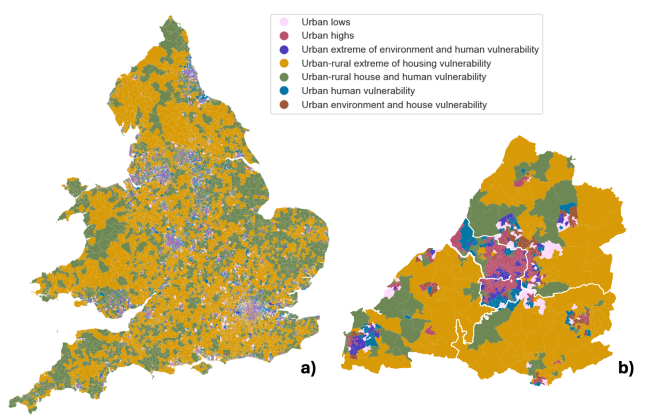Indoor Air Quality Vulnerability: Neighbourhood Insights for England and Wales
Nowadays, people in the Global North spend most of their time indoors (80-90%). Indoor air pollution has therefore become a major health concern and is increasingly recognised as an issue of environmental and social justice. Vulnerability to indoor air pollution is often interrelated with the health impacts of living in a cold home, and the activities of those living in fuel poverty, including rationing of energy or living homes that are difficult to heat, can promote the growth of mould or poor ventilation. Both exposure to poor-quality ambient environments (surrounding physical and material chemical conditions in a specific area) and vulnerability to adverse effects on health and well-being are disproportionately impacting specific neighbourhoods.
About the research
Our research creates a better understanding of the complex drivers of vulnerability to poor indoor air quality by visualising the three sources of indoor air pollution. First, environmental sources, such as traffic fumes, penetrate the material forms that constitute a person’s immediate surroundings. Second, structural sources occur within the build of a property, such as the type of heating or ventilation. Third, human sources are rooted in people’s behaviour in indoor spaces, such as smoking or overcrowding.
The findings allow for national, regional and local comparisons of air pollution vulnerability, which can be useful to a diverse range of stakeholders to assess potential exposure and guide intervention. The outputs of this research are threefold: a journal article, a policy brief and an accessible interactive map which allows policymakers, stakeholders and the general public to explore the data in an interactive way.
Policy implications
- Current policies need to acknowledge indoor air quality. A system of monitoring indoor air quality in current housing is needed; different systems might be required for various housing types. Current housing standards and building regulations must be amended to acknowledge indoor air quality and prioritise indoor air flow as well as energy efficiency.
- Ella’s law (Clean Air - Human Rights - Bill) should be fast-tracked and accepted as soon as possible.
- Local policy-makers should tailor interventions to the specific needs of rural and urban communities. For example in rural areas, outdoor air quality is generally good, but poor housing conditions often lead to indoor air pollution so improving housing stock is essential. A variety of climate resilience, housing improvements, and health support programmes are needed. These will be especially crucial for vulnerable populations.
- The general public should be supported to mitigate their air pollution exposure and identify the main sources of air pollution on their own property. Even basic air quality devices can help individuals identify sources of air pollution in their own spaces. The government should provide additional support for vulnerable individuals to build knowledge and make material changes to their environment that promote healthy indoor environments.
- Further data collection on air quality is needed, including granular surveys and the establishment of big data sources for understanding indoor air quality in UK households.

Key findings
The three indices of Indoor Air Quality (IAQ) show spatial patterns of the three main sources of indoor air pollution: environmental sources relate to the outdoor environment of the dwelling; structural are those from the structure of the dwelling; and human sources originate from people’s activities in the home.
Environmental IAQ is mainly associated with urbanity and built-in environment; accumulation of traffic, people’s activity and lack of green spaces. Although there is not enough data to comprehensively understand human activity in indoor spaces, the available data suggests that human-based IAQ is strongly associated with areas of high deprivation.
On the other hand, the spatial distribution of structural IAQ suggests a negative association with deprivation, meaning less deprived neighbourhoods are more likely to face air pollution sourced from heating and building characteristics.
We identify eight distinctive types of neighbourhoods with unique combinations of the three sources of indoor air pollution (environment, structure, human). Our research indicates that some neighbourhoods are facing high levels of air pollution sources in all three dimensions, while some show high levels in only one or two dimensions.

Further information
Interactive map where Indoor Air Quality indices can be explored by the public and policy-maker can be found at Clusters and Indices of Indoor Air Quality Vulnerability – Mapping Ambient Vulnerabilities
The author
Lenka Hasova, School of Geographical Sciences
